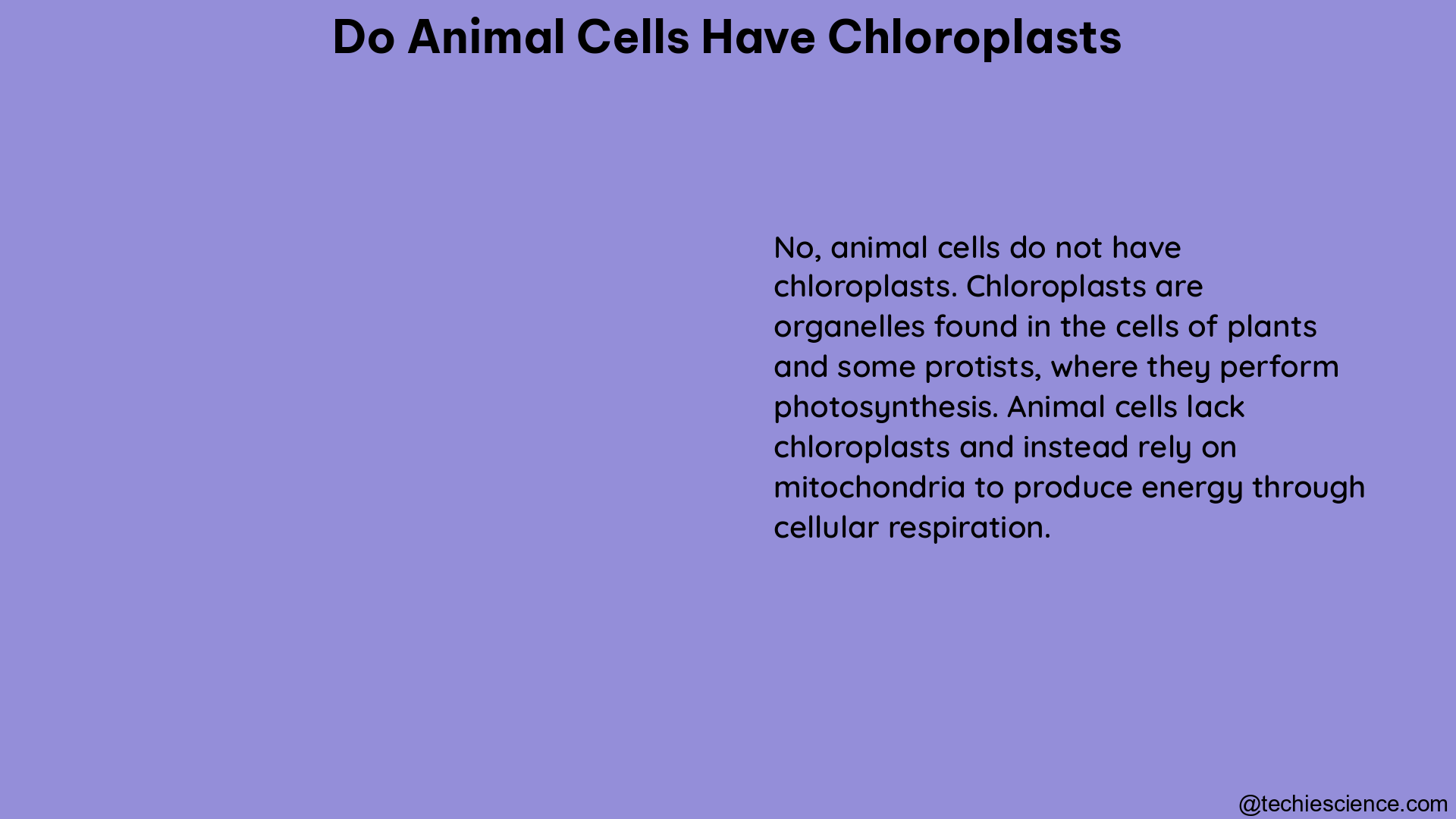Summary
Animal cells, in general, do not possess chloroplasts, the organelles responsible for photosynthesis in plant and algal cells. However, there are some exceptions, such as the sea slug Elysia chlorotica, which can acquire and utilize chloroplasts from the algae it consumes. This unique ability is not a typical characteristic of animal cells, which primarily obtain energy through the breakdown of other organisms rather than through photosynthesis.
Understanding the Presence of Chloroplasts in Animal Cells

Chloroplasts: The Photosynthetic Organelles
Chloroplasts are specialized organelles found in the cells of plants and algae. These organelles are responsible for the process of photosynthesis, which converts carbon dioxide and water into glucose and oxygen using the energy from sunlight. Chloroplasts contain the pigment chlorophyll, which absorbs light energy and powers the conversion of these raw materials into usable energy for the plant or alga.
The Absence of Chloroplasts in Typical Animal Cells
In general, animal cells do not possess chloroplasts. This is because animals obtain their energy through the consumption and breakdown of other organisms, rather than through the process of photosynthesis. The primary energy-generating processes in animal cells involve glycolysis and the citric acid cycle, which do not require the presence of chloroplasts.
Exceptions: Chloroplast-Containing Animal Cells
While chloroplasts are not a common feature of animal cells, there are a few exceptions where certain animals or animal cells can acquire and utilize chloroplasts. One notable example is the sea slug Elysia chlorotica, which is known to take up chloroplasts from the algae it consumes and use them for photosynthesis.
The Case of Elysia chlorotica
The sea slug Elysia chlorotica is a unique example of an animal that can incorporate chloroplasts into its own cells. This slug feeds on the green alga Vaucheria litorea, and during the feeding process, it is able to selectively uptake the chloroplasts from the algal cells. These chloroplasts then become integrated into the slug’s own cells, where they can continue to function and provide the slug with energy through photosynthesis.
This process, known as kleptoplasty, allows the sea slug to supplement its energy needs through photosynthesis, in addition to the traditional heterotrophic feeding on the algae. Researchers have found that the chloroplasts can remain functional and provide energy to the slug for several months, demonstrating the remarkable ability of this animal to harness the photosynthetic capabilities of its prey.
Other Chloroplast-Containing Animals
While the sea slug Elysia chlorotica is the most well-known example, there are a few other animals that have been observed to possess chloroplasts or chloroplast-like structures. These include:
-
Sacoglossan sea slugs: Similar to Elysia chlorotica, some other species of sacoglossan sea slugs have been found to incorporate chloroplasts from their algal prey into their own cells.
-
Platynereis dumerilii: This marine polychaete worm has been shown to contain chloroplast-like structures, which may have been acquired through a symbiotic relationship with photosynthetic microorganisms.
-
Stentor coeruleus: This freshwater ciliate protozoan has been observed to contain chloroplast-like structures, which may have been obtained through the ingestion of algae.
It is important to note that these examples are relatively rare and do not represent the typical characteristics of animal cells. The vast majority of animal cells do not possess chloroplasts and rely on other organelles, such as mitochondria, for their energy production.
The Role of Mitochondria in Animal Cells
While animal cells do not have chloroplasts, they do contain other organelles that are essential for energy production and storage. The primary energy-generating organelle in animal cells is the mitochondrion.
Mitochondria are responsible for the process of oxidative phosphorylation, which uses the energy from food molecules to produce ATP, the high-energy molecule that powers various cellular processes. Unlike chloroplasts, which use light energy to produce glucose, mitochondria rely on the breakdown of organic molecules, such as glucose, to generate ATP.
The presence of mitochondria in animal cells is crucial for their ability to obtain energy and sustain their metabolic activities. These organelles play a vital role in the overall energy metabolism of animal cells, compensating for the lack of chloroplasts and the photosynthetic capabilities found in plant and algal cells.
Conclusion
In summary, while there are a few exceptions, such as the sea slug Elysia chlorotica, animal cells generally do not possess chloroplasts. The primary energy-generating processes in animal cells involve the breakdown of organic molecules through glycolysis and the citric acid cycle, rather than the photosynthetic processes that occur in chloroplasts. Instead, animal cells rely on mitochondria to produce the necessary ATP for their cellular functions.
The absence of chloroplasts in animal cells is a fundamental difference between the energy-producing mechanisms of plants/algae and animals, reflecting their distinct evolutionary adaptations and ecological roles.
References
- Rumpho, M. E., Worful, J. M., Lee, J., Kannan, K., Tyler, M. S., Bhattacharya, D., … & Manhart, J. R. (2008). Horizontal gene transfer of the algal nuclear gene psbO to the photosynthetic sea slug Elysia chlorotica. Proceedings of the National Academy of Sciences, 105(46), 17867-17871.
- Bhattacharya, D., Pelletreau, K. N., Ramesh, A. K., Weber, A. P., & Rumpho, M. E. (2013). How do marine slugs steal their metabolic weapons from algae?. Aquatic Microbial Ecology, 72(1), 57-66.
- Serôdio, J., Cruz, S., Cartaxana, P., & Calado, R. (2014). Photophysiology of kleptoplasts: photosynthetic use of light by chloroplasts retained by solar-powered sea slugs. Philosophical Transactions of the Royal Society B: Biological Sciences, 369(1640), 20130242.
- Rauch, C., Jahns, P., Tielens, A. G., & Gould, S. B. (2019). Plastid acquisition in Paulinella chromatophora. Advances in Botanical Research, 92, 53-72.
- Gould, S. B., Waller, R. F., & McFadden, G. I. (2008). Plastid evolution. Annual review of plant biology, 59, 491-517.
Hi..I am Moumita Nath, I have completed my Master’s in Biotechnology. I always like to explore new areas in the field of Biotechnology.
Apart from this, I like to read, travel and listen to Music.